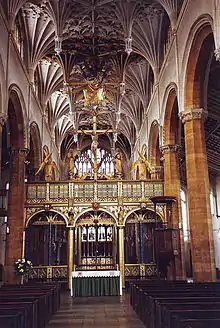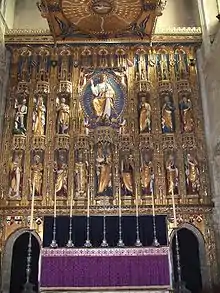Ninian Comper
Sir (John) Ninian Comper (10 June 1864 – 22 December 1960)[1][2] was a Scottish-born architect. He was one of the last of the great Gothic Revival architects,[3] noted for his churches and their furnishings. He is well known for his stained glass, his use of colour and his subtle integration of Classical and Gothic elements which he described as unity by inclusion.[4]
Ninian Comper | |
|---|---|
 The interior of St Mary's, Wellingborough | |
| Born | 10 June 1864 Aberdeen, Scotland |
| Died | 22 December 1960 (aged 96) Clapham, London, United Kingdom |
| Nationality | British |
| Occupation | Architect |
| Practice | Bucknall & Comper |
Career
Comper was born in Aberdeen, the eldest of five children of Ellen Taylor of Hull and the Reverend John Comper, Rector of St John's, Aberdeen (and later St Margaret of Scotland). He was educated at Kingston College, Aberdeen, Glenalmond School in Perthshire and attended a year at the Ruskin School of Art in Oxford. On moving to London, he was articled to Charles Eamer Kempe, and in 1883 to George Frederick Bodley and Thomas Garner. His fellow-Scot William Bucknall took him into partnership in London in 1888 and Ninian was married to Grace Bucknall in 1890. Bucknall and Comper remained in partnership until 1905.[5]
His ecclesiastical commissions include a line of windows in the north wall of the nave of Westminster Abbey; at St Peter's Church, Huddersfield, baldachino/ciborium, high altar and east window in memory of the dead of the Great War; St Mary's, Wellingborough; St Michael & All Angels, Inverness; the Lady Chapel at Downside Abbey, Somerset; the ciborium and House Chapel extension for the Society of St. John the Evangelist in Oxford (now St Stephen's House, Oxford) and St Cyprian's, Clarence Gate, London; the Lady Chapel at St Matthew's, Westminster; Lady Chapel and gilded paintings in the chancel of All Saints, Margaret Street. He also designed the main building for infants for St Mary & St John School on Hertford Street in Oxford which is now called the Comper Foundation Stage School. In 1936–38 he designed "one of his most famous and original churches": St Philip's Church at Cosham near Portsmouth.[4]
Comper is noted for re-introducing the 'English altar', an altar surrounded by riddel posts. Comper designed a number of remarkable altar screens (reredos), inspired by medieval originals. Wymondham Abbey, Norfolk, has one example.[6]

Only one major ecclesiastical work of Comper's is in the United States, the Leslie Lindsey Chapel of Boston's Emmanuel Episcopal Church. The work is an all-encompassing product of and testimony to Comper's design capability, comprising the entire decorative scheme of the chapel designed by the architectural firm of Allen & Collins. Comper designed its altar, altar screen, pulpit, lectern, dozens of statues, all its furnishings and appointments, and most notably the stained glass windows.[7] The chapel commemorates Leslie Lindsey and Stewart Mason, her husband of ten days, who were married at Emmanuel Church and perished when the Lusitania was torpedoed in 1915.[8]
From 1912 Comper and his wife lived in London at The Priory, Beulah Hill, a house designed by Decimus Burton (1800–81), where he entertained friends such as John Betjeman. He had a studio nearby at Knights Hill, close to the world's first Gothic Cemetery at West Norwood. After the studio was destroyed in World War II it was relocated to a building in his garden, which had previously been used by his son, Nicholas Comper (1897–1939), to design aircraft.[9]
Comper was knighted by King George VI in 1950.[10]
On 22 December 1960 he died in The Hostel of God (now Trinity Hospice) in Clapham. His body was brought back to Norwood for cremation at West Norwood Cemetery.[11] His ashes were then interred beneath the windows he designed in Westminster Abbey.[12]
References
- Buckley, Leonard (1994). Sir Ninian Comper, 1864–1960 and Howard Martin Otto (Otho) Travers, 1886–1948: A Belated Tribute. Ecclesiological Society.
- Symondson, Anthony (1988). The Life and Work of Sir Ninian Comper 1864–1960: Catalogue for the Exhibition at the Royal Institute of British Architects, 20 January Until 27 February 1988. Royal Institute of British Architects.
- Symondson, Anthony; Bucknall, Stephen Arthur (2006). Sir Ninian Comper: An Introduction to His Life and Work, With Complete Gazetteer. Spire Books & the Ecclesiological Society. ISBN 978-1-904965-11-4.
- Pevsner & Lloyd 1967, p. 464.
- Basic biographical details of (Sir) John Ninian Comper at the Dictionary of Scottish Architects Biographical Database.
- Pevsner & Wilson 2002, p. 797.
- "Design for the Leslie Lindsey Memorial Chapel, Emmanuel Church, Boston, Massachusetts". RIBApix. Retrieved 29 November 2017.
- "History of Lindsey Chapel".
- Bucknall, Stephen Arthur. "Sir Ninian Comper in Norwood". The Norwood Society. Archived from the original on 27 March 2012.
- "005A: Sir Ninian Comper". www.norwoodsociety.co.uk.
- West Norwood Cemetery registers. Cremations, 29 December 1960
- "Obituary, Sir Ninian Comper". The Times. 23 December 1960.
Sources
- Pevsner, Nikolaus; Lloyd, David W. (1967). Hampshire and The Isle of Wight. The Buildings of England. London: Yale University Press. ISBN 978-0-300-09606-4.
- Pevsner, Nikolaus; Wilson, Bill (2002). Norfolk 2: North-West and South. The Buildings of England. London: Yale University Press. ISBN 0-300-09657-7.
External links
| Wikimedia Commons has media related to Ninian Comper. |
- Basic biographical details of Bucknall & Comper at the Dictionary of Scottish Architects Biographical Database.
- "Huddersfield Parish Church History". Huddersfield Parish Church. Retrieved 23 February 2010.
- "The Comper Jewel in the Highlands of Scotland". The Church of St Michael and All Angels. Retrieved 23 February 2010.
- Shawn Tribe. "Sir J. Ninian Comper and the Sisters of Bethany". Retrieved 22 July 2013.
- "Westminster Abbey stained glass windows - the nave". Archived from the original on 7 August 2007. Retrieved 23 February 2010.